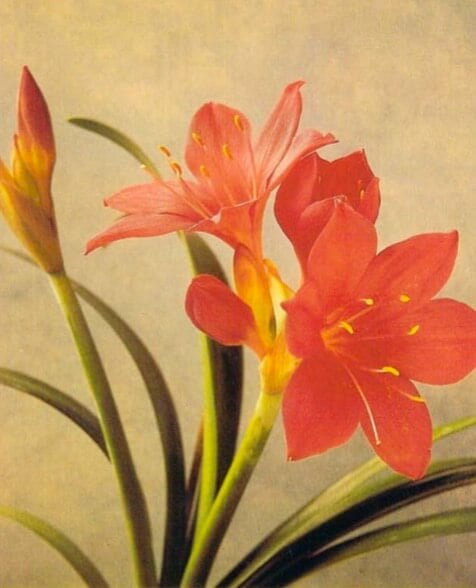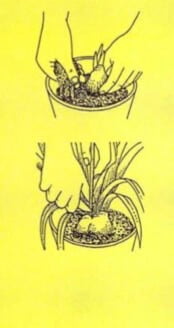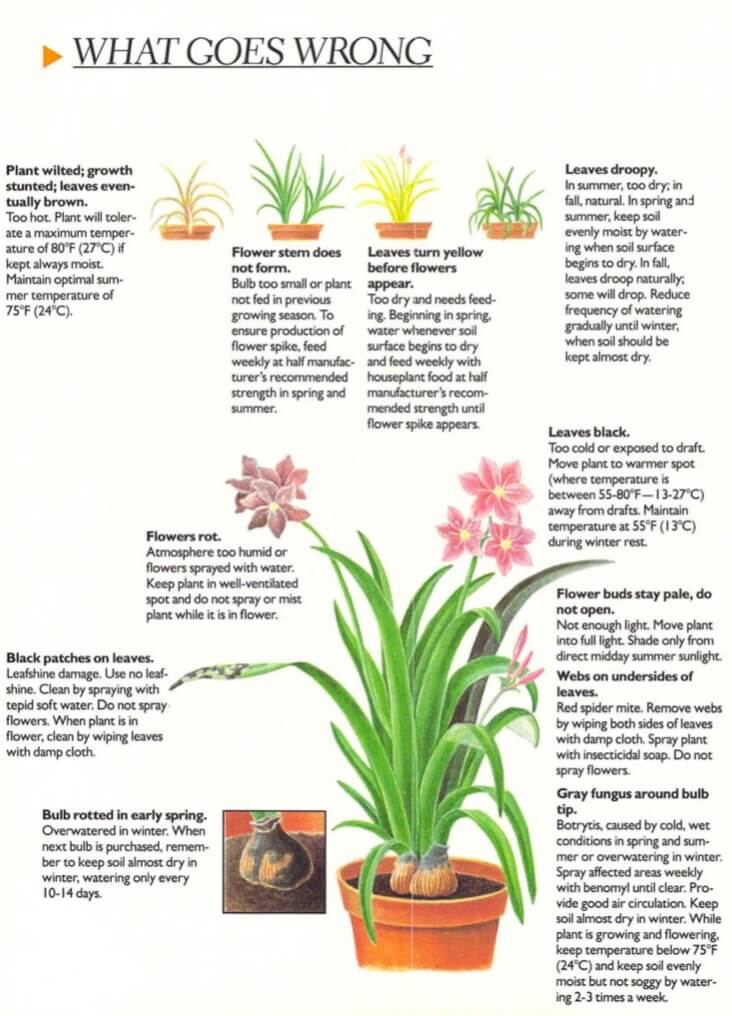[Ebook Việt Hoá] The Instant Guide to Healthy Houseplants (Hướng dẫn tức thời để chăm cây trong nhà khoẻ mạnh), Chi Cyrtanthus - Chi Vallota
[Ebook Việt Hoá] The Instant Guide to Healthy Houseplants: Vallota Speciosa (Scarborough lily)
- Nguồn: [Ebook Việt Hoá] The Instant Guide to Healthy Houseplants (Hướng dẫn tức thời để chăm cây trong nhà khoẻ mạnh)
- Biên tập: Dũng Cá Xinh
- Biên dịch: Team Codai.net
English
This beautiful native of South Africa is easy to grow in a light, warm spot such as a sunny windowsill. Bulbs planted in midsummer will produce a mass of striking bright red blooms in late summer. The plant grows to a maximum height of about 12 inches (30 cm), producing new leaves each spring. Scarborough lily needs a winter resting period but keeps some leaves year-round. The plant can be left in its pot for 3-4 years.

Light
Needs full light, including some direct sunlight, but shade from direct midday summer sunlight.
Temperature
During 2-month winter rest period, maintain a temperature of 55°F (13°C). While plant is growing and flowering, keep temperature below 75°F (24°C), if possible, and move plant out of direct sunlight if temperature exceeds maximum.
Water
In spring and summer, keep soil evenly moist by watering 2-3 times a week. In winter, water every 10-14 days.
Soil
Use equal parts loam and peat, or use soilless potting mix.
Feeding
From early spring to late fall, feed weekly with houseplant food at half the manufacturer’s recommended strength.
Cleaning
Spray with tepid soft water. Do not spray flowers. When plant is in flower, wipe leaves with damp cloth.
Propagation
Plant new bulbs in midsummer in barely moist, fibrous soil, then do not water until new leaves start to grow. A large bulb needs as-in (13-cm) pot and should be planted with the tip showing above the surface. Plant can be left in its pot for 3-4 years. Change the top 1 in (2.5 em) of soil in spring.
Offsets
If offsets around parent bulb are crowding pot, remove them in spring. Pot them singly in 3 1/2-in (9-cm) pots, where they will flower in 2-3 years.
Humidity
If temperature exceeds 80°F (27°C), mist leaves. Do not mist flowers; they will rot. Provide good air circulation.
After flowering
Allow flower stem to dry out. After about 5 weeks or when stem is yellow, use sharp knife or razor blade to cut stem (not leaves) just above top of bulb. (Do not use scissors.) Reduce frequency of watering, allowing soil surface to dry between waterings, and reduce frequency of feeding t o once a month. When leaves start to turn yellow, stop feeding and move plant to cooler place (55°F-13°C) for winter resting period

What Goes Wrong

- Plant wilted; growth stunted; leaves eventually brown: Too hot. Plant will tolerate a maximum temperature of 80°F (27°C) if kept always moist. Maintain optimal summer temperature of 75°F (24°C).
- Flower stem does not form: Bulb too small or plant not fed in previous growing season. To ensure production of flower spike, feed weekly at half manufacturer’s recommended strength in spring and summer.
- Flowers rot: Atmosphere too humid or flowers sprayed with water. Keep plant in well-ventilated spot and do not spray or mist plant while it is in flower.
- Leaves turn yellow before flowers appear: Too dry and needs feeding. Beginning in spring, water whenever soil surface begins to dry and feed weekly with houseplant food at half manufacturer’s recommended strength until flower spike appears.
- Leaves droopy: In summer, too dry; in fall, natural. In spring and summer, keep soil evenly moist by watering when soil surface begins to dry. In fall, leaves droop naturally; some will drop. Reduce frequency of watering gradually until winter, when soil should be kept almost dry.
- Leaves black: Too cold or exposed to draft. Move plant to warmer spot (where temperature is between 55-80°F – 13-27°C) away from drafts. Maintain temperature at 55°F(13°C) during winter rest.
- Flower buds stay pale, do not open: Not enough light. Move plant into full light. Shade only from direct midday summer sunlight.
- Webs on undersides of leaves: Red spider mite. Remove webs by wiping both sides of leaves with damp cloth. Spray plant with insecticidal soap. Do not spray flowers.
- Gray fungus around bulb tip: Botrytis, caused by cold, wet conditions in spring and summer or overwatering in winter. Spray affected areas weekly with benomyl until clear. Provide good air circulation. Keep soil almost dry in winter. While plant is growing and flowering,
keep temperature below 75°F (24°C) and keep soil evenly moist but not soggy by watering 2-3 times a week. - Black patches on leaves. Leafshine damage: Use no leafshine. Clean by spraying with tepid soft water. Do not spray flowers. When plant is in flower, clean by wiping leaves with damp cloth.
- Bulb rotted in early spring: Overwatered in winter. When next bulb is purchased, remember to keep soil almost dry in winter, watering only every 10-14 days.
Tiếng Việt
Loài cây xinh đẹp có nguồn gốc từ Nam Phi này rất dễ trồng ở nơi có ánh sáng và ấm áp như bệ cửa sổ đầy nắng. Củ được trồng vào giữa hè sẽ tạo ra một loạt các bông hoa màu đỏ tươi nổi bật vào cuối hè. Cây phát triển đến chiều cao tối đa khoảng 30 cm và ra lá mới vào mỗi mùa xuân. Scarborough lily cần nghỉ ngơi vào mùa đông nhưng vẫn giữ một số lá quanh năm. Cây có thể trồng trong chậu từ 3-4 năm.

Ánh sáng
Cần ánh sáng đầy đủ, bao gồm ánh náng mặt trời trực tiếp, nhưng che mát cho cây khỏi ánh nắng trực tiếp giữa trưa mùa hè.
Nhiệt độ
Trong thời gian 2 tháng nghỉ đông, duy trì nhiệt độ 55 ° F (13 ° C). Trong khi cây đang phát triển và ra hoa, hãy giữ nhiệt độ dưới 75 ° F (24 ° C) và di chuyển cây ra khỏi ánh nắng trực tiếp nếu nhiệt độ vượt quá mức tối đa.
Nước
Vào mùa xuân và mùa hè, giữ ẩm đều cho đất bằng cách tưới nước 2-3 lần một tuần. Vào mùa đông, tưới 10-14 ngày một lần.
Đất
Sử dụng đất mùn và than bùn hai phần bằng nhau, hoặc sử dụng hỗn hợp bầu không đất.
Bón phân
Từ đầu mùa xuân đến cuối mùa thu, hàng tuần sử dụng phân bón hữu cơ với liều lượng một nửa khuyến cáo của nhà sản xuất.
Làm sạch
Xịt bằng nước mềm ấm. Không xịt vào hoa. Khi cây ra hoa, lau lá bằng khăn ẩm.
Nhân giống
Trồng củ mới vào giữa mùa hè trên đất vừa ẩm vừa xơ, sau đó không tưới nước cho đến khi lá mới bắt đầu mọc. Củ lớn cần chậu khoảng 5 inch (13 cm) và nên trồng phần ngọn nhô lên trên bề mặt. Cây có thể để trong chậu từ 3-4 năm. Thay 1 inch (2,5 cm) trên cùng của đất vào mùa xuân.
Chồi cây
Nếu các khoảng lệch xung quanh củ chính chật chội, hãy loại bỏ chúng vào mùa xuân. Chỉ trồng chúng trong chậu 1/2 inch (9 cm), chúng sẽ ra hoa trong 2-3 năm.
Độ ẩm
Nếu nhiệt độ vượt quá 80 ° F (27 ° C), phun ẩm cho lá. Không phun ẩm cho hoa; chúng sẽ thối rữa. Lưu thông không khí tốt.
Sau khi ra hoa
Để cuống hoa khô. Sau khoảng 5 tuần hoặc khi thân cây có màu vàng, dùng dao sắc hoặc lưỡi lam để cắt phần thân (không phải lá) ngay phía trên đầu củ. (Không dùng kéo.) Giảm tần suất tưới nước, để bề mặt đất khô giữa các lần tưới và giảm tần suất bón phân mỗi tháng một lần. Khi lá bắt đầu chuyển sang màu vàng, ngừng bón phân và chuyển cây đến nơi mát hơn (55 ° F – 13 ° C) cho thời gian nghỉ đông.

Những vấn đề có thể xảy ra

- Cây héo úa; còi cọc; cuối cùng lá có màu nâu: Quá nóng. Cây sẽ chịu được nhiệt độ tối đa là 80 ° F (27 ° C) nếu luôn được giữ ẩm. Duy trì nhiệt độ mùa hè tối ưu là 75 ° F (24 ° C).
- Thân hoa không hình thành: Củ quá nhỏ hoặc cây không được nuôi dưỡng trong mùa sinh trưởng trước. Để đảm bảo sản xuất ra cành hoa, hãy bón phân hàng tuần với liều lượng bằng một nửa khuyến cáo của nhà sản xuất vào mùa xuân và mùa hè.
- Hoa bị thối: Không khí quá ẩm hoặc hoa bị phun nước. Giữ cây ở nơi thông thoáng và không phun sương hoặc phun sương cho cây khi cây đang ra hoa.
- Lá chuyển sang màu vàng trước khi hoa xuất hiện: Quá khô và cần bón phân. Bắt đầu từ mùa xuân, tưới nước bất cứ khi nào bề mặt đất bắt đầu khô và hàng tuần sử dụng phân bón cho cây trồng tại nhà với liều lượng một nửa theo khuyến nghị của nhà sản xuất cho đến khi cành hoa xuất hiện.
- Lá rũ xuống: Vào mùa hè, quá khô; vào mùa thu, tự nhiên. Vào mùa xuân và mùa hè, giữ ẩm đều cho đất bằng cách tưới nước khi bề mặt đất bắt đầu khô. Vào mùa thu, lá rủ xuống một cách tự nhiên; một số sẽ rơi xuống. Giảm dần tần suất tưới nước cho đến mùa đông, khi đất gần như khô ráo.
- Lá bị đen: Quá lạnh hoặc tiếp xúc với gió lùa. Di chuyển cây đến nơi ấm hơn (nơi có nhiệt độ từ 55-80 ° F – 13-27 ° C) tránh xa gió lùa. Duy trì nhiệt độ ở mức 55 ° F (13 ° C) trong thời gian nghỉ đông.
- Nụ hoa xanh xao, không hé nở: Không đủ ánh sáng. Di chuyển cây ra nơi có ánh sáng đầy đủ. Chỉ tránh ánh nắng trực tiếp giữa trưa hè.
- Mạng nhện ở mặt dưới lá: Nhện đỏ. Loại bỏ mạng nhện bằng cách lau cả hai mặt của lá bằng khăn ẩm. Phun xà phòng diệt côn trùng cho cây. Không phun hoa.
- Nấm xám quanh đầu củ: Bệnh nấm mốc, gây ra bởi điều kiện ẩm ướt vào mùa xuân và mùa hè hoặc tưới nước quá nhiều vào mùa đông. Xịt các khu vực bị ảnh hưởng hàng tuần với benomyl cho đến khi sạch. Thoát nước tốt. Giữ cho đất gần như khô ráo vào mùa đông. Trong khi cây đang phát triển và ra hoa, hãy giữ nhiệt độ dưới 75 ° F (24 ° C) và giữ cho đất ẩm đều nhưng không bị sũng nước bằng cách tưới 2-3 lần một tuần.
- Các mảng đen trên lá. Hư hại do xịt bóng lá: Không sử dụng xịt bóng lá. Làm sạch bằng cách phun với nước mềm ấm. Không phun hoa. Khi cây ra hoa, lau sạch lá bằng khăn ẩm.
- Củ bị thối rữa vào đầu mùa xuân: Bị ngập úng vào mùa đông. Khi mua củ tiếp theo, hãy nhớ giữ đất gần như khô trong mùa đông, chỉ tưới 10-14 ngày một lần.



